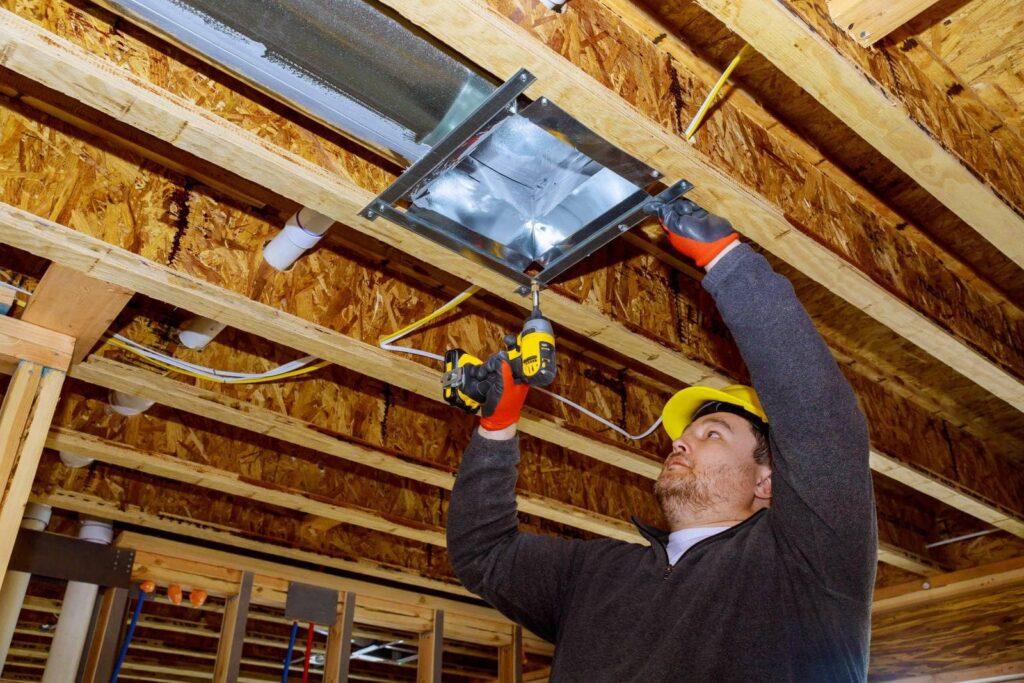Air Sealing for Winter: Improve Comfort and Block Pests
As temperatures drop and heating systems work overtime, homeowners start noticing the usual winter problems: cold drafts, uneven room temperatures, and rising energy bills. But one issue often goes overlooked—air leaks.
Tiny cracks and gaps around windows, vents, foundations, and attics do more than just let warm air escape. They allow pests like mice, rats, and insects to slip inside seeking warmth and shelter. Fortunately, there’s a single home improvement that solves both problems—air sealing.
In this comprehensive guide, you’ll learn how air sealing improves energy efficiency, enhances indoor air quality, and acts as a powerful defense against rodent infestations—making it one of the smartest upgrades you can make before winter truly sets in.
Why Air Sealing Matters During Winter
Air sealing is the process of closing up cracks, holes, and gaps in your home’s envelope—especially in areas like the attic, crawl space, and foundation. It prevents the uncontrolled movement of air between indoors and outdoors, helping maintain consistent temperatures and improve energy efficiency.
But during the cold months, it serves another critical purpose: it stops pests from finding their way inside.
Here’s why this matters:
- Warmth attracts rodents. Mice and rats can detect heat loss around openings and follow it to entry points.
- Moisture invites pests. Gaps also allow humid air and condensation to form, creating ideal nesting conditions.
- Air leaks spread allergens and odors. Unsealed gaps can draw in dust, pollen, and even odors from crawl spaces or basements.
By creating a tight seal, you’re not just improving comfort—you’re defending your home from hidden threats.
The Hidden Costs of Air Leaks
Unsealed homes waste more energy than you might think. Studies by the U.S. Department of Energy estimate that air leaks can account for 25–40% of total heating and cooling loss in older houses.
That translates into:
- Higher energy bills throughout winter.
- Overworked HVAC systems, leading to premature wear.
- Cold spots and drafts in certain rooms.
- Poor indoor air quality, as unfiltered air enters from attics or crawl spaces.
Even small cracks around plumbing penetrations, attic hatches, and recessed lighting can add up to the equivalent of leaving a window open year-round.
How Air Sealing Helps with Pest Prevention
Air leaks do more than lose heat—they create literal doorways for pests. Mice can squeeze through a hole as small as a pencil eraser. Once inside, they find insulation to nest in, wires to chew on, and food sources to raid.
Here’s how air sealing acts as pest control:
1. 🚫 Blocks Common Entry Points
By sealing cracks, vents, and foundation gaps, you eliminate the pathways rodents use to invade. Expanding foam, caulk, and metal flashing all create barriers that pests can’t chew through.
2. 🧱 Reduces Moisture That Attracts Rodents
Moist, humid air inside crawl spaces and basements encourages mold and insects—both of which attract rodents. Air sealing prevents humid outdoor air from entering, keeping these spaces dry and less appealing.
3. 🧹 Limits Access to Food and Shelter
Rodents and insects use air leaks to move between walls, attics, and pantries. Once sealed, they’re trapped outside where they belong.
4. 🧘♂️ Creates a Cleaner Indoor Environment
Unsealed gaps pull in air from crawl spaces or garages that may contain contaminants like dust, pesticides, and rodent droppings. Air sealing improves indoor air quality and reduces health risks.
Where Air Leaks—and Pests—Hide
Air sealing starts with knowing where to look. Many problem areas are out of sight but cause major energy loss and pest entry.
🏠 Attic and Roof
- Gaps around light fixtures, fans, and attic hatches.
- Cracks near chimneys, vents, or soffits.
- Unsealed seams where roof framing meets the ceiling.
Attics are especially vulnerable to rodents because they’re warm, dry, and accessible from roof edges. Spray foam insulation can fill these voids, creating both an air barrier and pest deterrent.
🧱 Foundation and Crawl Spaces
- Cracks in the foundation or along sill plates.
- Gaps around plumbing and utility lines.
- Open vents or poorly sealed crawl space doors.
Moisture in these areas attracts rodents and insects. Pairing air sealing with vapor barriers or sump pumps ensures both dry conditions and pest resistance.
🚪 Doors and Windows
- Worn weather stripping or missing door sweeps.
- Cracks around frames or between glass panes.
- Loose-fitting basement or attic access doors.
Replacing or repairing seals prevents both air loss and rodent entry. Use silicone caulk or foam backer rods to close small gaps, and upgrade to energy-efficient, tight-fitting frames where needed.
🌬 Utility Penetrations and Vents
- Openings around HVAC lines, electrical conduits, and dryer vents.
- Exhaust fans that lack covers or flaps.
- Cable or plumbing entry points.
These are some of the most common rodent entry spots. Seal with steel wool + caulk for small holes and metal mesh for larger ones.
The Process: How Air Sealing Works
Professional air sealing typically involves a blower door test, which depressurizes your home to reveal where air leaks occur. But even without specialized tools, homeowners can identify and address the biggest gaps themselves.
Here’s a step-by-step approach:
Step 1: Inspect for Leaks
Use your hand or an incense stick near doors, windows, and outlets. If you feel a draft or see smoke movement, you’ve found a leak.
Step 2: Seal Small Cracks and Gaps
Apply caulk, foam sealant, or weather stripping to close visible holes. Focus on baseboards, wall penetrations, and window perimeters.
Step 3: Fill Larger Openings
Use expanding foam insulation for wide gaps around plumbing or wiring. For high-moisture areas, use foam rated for “closed-cell” waterproof applications.
Step 4: Add Insulation for Extra Protection
Insulation complements air sealing by maintaining temperature and reducing condensation. Spray foam insulation, in particular, doubles as a pest barrier due to its density and sealing properties.
Step 5: Maintain Regularly
Reinspect every season. Weather and foundation movement can reopen gaps, especially near doors and windows.
Air Sealing and Indoor Air Quality
One of the biggest benefits of air sealing—beyond comfort and pest control—is improved indoor air quality.
Unsealed homes allow air from crawl spaces, attics, and garages to mix with indoor air. That means dust, mold spores, and even exhaust fumes can circulate through your living spaces.
Proper sealing:
- Reduces infiltration of outdoor pollutants and allergens.
- Keeps humidity levels consistent, limiting mold growth.
- Helps HVAC systems maintain balanced air pressure and filtration.
Pairing air sealing with a controlled ventilation system (like an HRV or ERV) ensures fresh air enters intentionally—filtered, not through cracks and crevices.
Long-Term Benefits of Air Sealing
Air sealing is one of the most cost-effective home upgrades available, with benefits that extend far beyond just lower heating bills.
💰 1. Energy Savings
By reducing heat loss, homeowners can save up to 20% on heating and cooling costs each year.
🧘♀️ 2. Greater Comfort
Eliminating drafts creates consistent temperatures in every room—no more freezing hallways or overheated living areas.
🌬 3. Healthier Air
Cleaner, drier air means fewer allergens, less mold, and a more breathable home environment.
🐭 4. Rodent Resistance
A tightly sealed home leaves rodents with nowhere to enter, reducing pest control costs and preventing insulation damage.
🛠 5. Structural Protection
Keeping moisture and pests out prevents long-term damage to wood framing, drywall, and insulation.
When to Call in the Professionals
While homeowners can handle small sealing projects, professional air sealing offers deeper protection. Experts use thermal imaging, blower door tests, and infrared cameras to find leaks invisible to the naked eye.
Professional contractors also ensure:
- Proper ventilation balance after sealing.
- Safe handling of insulation materials.
- Compliance with building code standards for energy efficiency.
If you’re planning major upgrades—like attic insulation replacement, crawl space encapsulation, or foundation repairs—it’s smart to include air sealing as part of the project.
Winter Maintenance Tips
To maximize your home’s efficiency and pest protection all season:
- Inspect caulking annually. Replace cracked or peeling sections.
- Check attic insulation. Cold spots or condensation may indicate air leaks.
- Clean and seal vents. Make sure exterior vents are covered with rodent-proof mesh.
- Monitor humidity levels. Keep indoor humidity between 35–50% to discourage pests.
- Test sump pumps and vapor barriers. A dry crawl space helps maintain air quality.
Final Thoughts: Tighten, Seal, and Stay Comfortable
Winter brings its share of challenges—cold weather, higher energy bills, and persistent pests—but one solution addresses them all: air sealing.
By sealing cracks, reinforcing insulation, and eliminating moisture-prone gaps, you’ll create a tight seal that keeps warm air inside, pests outside, and your family comfortable all season long.
✅ Improve energy efficiency.
✅ Enhance indoor air quality.
✅ Block rodent and pest entry points.
✅ Enjoy consistent comfort through winter and beyond.
Don’t wait for the first cold draft or scratching sound in your walls—start sealing today.
📞 Ready for a professional air sealing inspection? Contact your local home energy expert to make your house warmer, cleaner, and pest-free before winter settles in.

